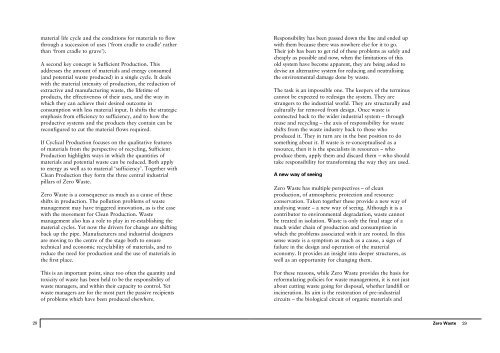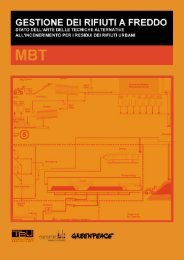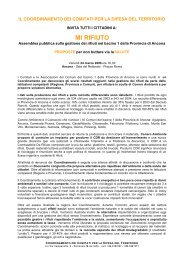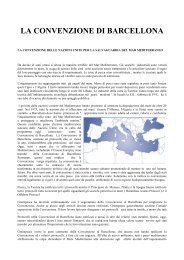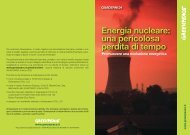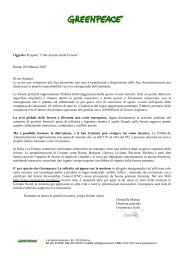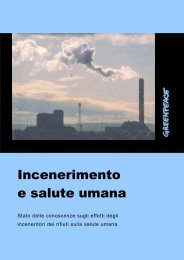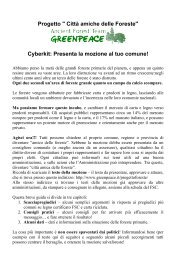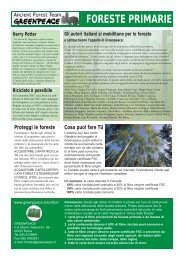Zero Waste by Robin Murray, Greenpeace Environmental Trust 2002
Zero Waste by Robin Murray, Greenpeace Environmental Trust 2002
Zero Waste by Robin Murray, Greenpeace Environmental Trust 2002
You also want an ePaper? Increase the reach of your titles
YUMPU automatically turns print PDFs into web optimized ePapers that Google loves.
material life cycle and the conditions for materials to flow<br />
through a succession of uses (‘from cradle to cradle’ rather<br />
than ‘from cradle to grave’).<br />
A second key concept is Sufficient Production. This<br />
addresses the amount of materials and energy consumed<br />
(and potential waste produced) in a single cycle. It deals<br />
with the material intensity of production, the reduction of<br />
extractive and manufacturing waste, the lifetime of<br />
products, the effectiveness of their uses, and the way in<br />
which they can achieve their desired outcome in<br />
consumption with less material input. It shifts the strategic<br />
emphasis from efficiency to sufficiency, and to how the<br />
productive systems and the products they contain can be<br />
reconfigured to cut the material flows required.<br />
If Cyclical Production focuses on the qualitative features<br />
of materials from the perspective of recycling, Sufficient<br />
Production highlights ways in which the quantities of<br />
materials and potential waste can be reduced. Both apply<br />
to energy as well as to material ‘sufficiency’. Together with<br />
Clean Production they form the three central industrial<br />
pillars of <strong>Zero</strong> <strong>Waste</strong>.<br />
<strong>Zero</strong> <strong>Waste</strong> is a consequence as much as a cause of these<br />
shifts in production. The pollution problems of waste<br />
management may have triggered innovation, as is the case<br />
with the movement for Clean Production. <strong>Waste</strong><br />
management also has a role to play in re-establishing the<br />
material cycles. Yet now the drivers for change are shifting<br />
back up the pipe. Manufacturers and industrial designers<br />
are moving to the centre of the stage both to ensure<br />
technical and economic recyclability of materials, and to<br />
reduce the need for production and the use of materials in<br />
the first place.<br />
This is an important point, since too often the quantity and<br />
toxicity of waste has been held to be the responsibility of<br />
waste managers, and within their capacity to control. Ye t<br />
waste managers are for the most part the passive re c i p i e n t s<br />
of problems which have been produced elsewhere .<br />
Responsibility has been passed down the line and ended up<br />
with them because there was nowhere else for it to go.<br />
Their job has been to get rid of these problems as safely and<br />
cheaply as possible and now, when the limitations of this<br />
old system have become apparent, they are being asked to<br />
devise an alternative system for reducing and neutralising<br />
the environmental damage done <strong>by</strong> waste.<br />
The task is an impossible one. The keepers of the terminus<br />
cannot be expected to redesign the system. They are<br />
strangers to the industrial world. They are structurally and<br />
culturally far removed from design. Once waste is<br />
connected back to the wider industrial system – through<br />
reuse and recycling – the axis of responsibility for waste<br />
shifts from the waste industry back to those who<br />
produced it. They in turn are in the best position to do<br />
something about it. If waste is re-conceptualised as a<br />
resource, then it is the specialists in resources – who<br />
produce them, apply them and discard them – who should<br />
take responsibility for transforming the way they are used.<br />
A new way of seeing<br />
<strong>Zero</strong> <strong>Waste</strong> has multiple perspectives – of clean<br />
production, of atmospheric protection and resource<br />
conservation. Taken together these provide a new way of<br />
analysing waste – a new way of seeing. Although it is a<br />
contributor to environmental degradation, waste cannot<br />
be treated in isolation. <strong>Waste</strong> is only the final stage of a<br />
much wider chain of production and consumption in<br />
which the problems associated with it are rooted. In this<br />
sense waste is a symptom as much as a cause, a sign of<br />
failure in the design and operation of the material<br />
economy. It provides an insight into deeper structures, as<br />
well as an opportunity for changing them.<br />
For these reasons, while <strong>Zero</strong> <strong>Waste</strong> provides the basis for<br />
reformulating policies for waste management, it is not just<br />
about cutting waste going for disposal, whether landfill or<br />
incineration. Its aim is the restoration of pre-industrial<br />
circuits – the biological circuit of organic materials and<br />
28<br />
<strong>Zero</strong> <strong>Waste</strong><br />
29


